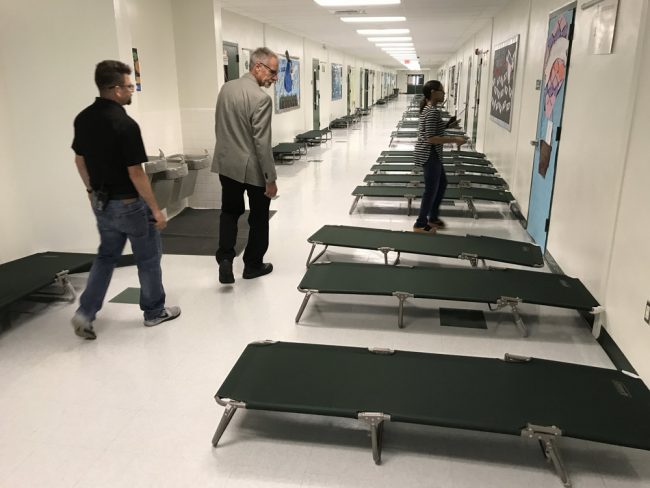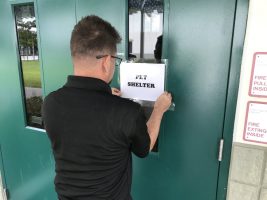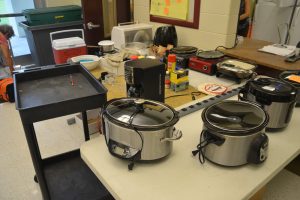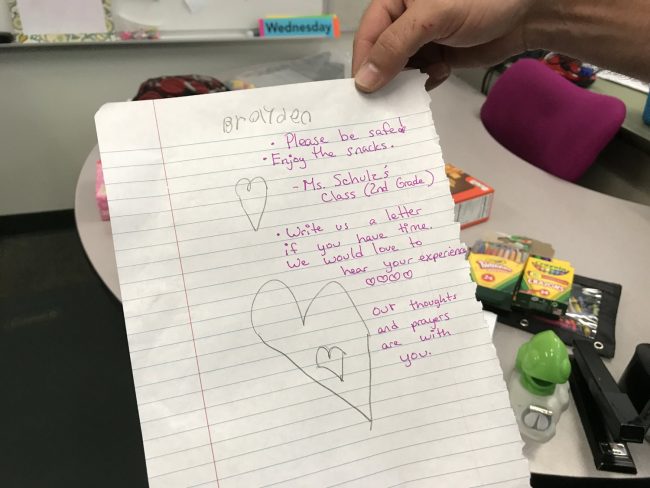
Amanda Schultz’s second-grade class left a message, written in red pen and pencil on lined notebook paper, for those who might use Bunnell Elementary as a shelter in the next few days: “Please be safe. ” “Enjoy the snacks.” “Write us a letter if you have time. We would love to hear your experience. ♥ ♥ ♥ ♥.” A student had drawn three hearts in pencil, one of them inside another. Then there was this: “Our thoughts and prayers are with you.”
The note, found this morning as Superintendent James Tager and district spokesman Jason Wheeler toured the four shelters getting ready to welcome residents evading Hurricane Irma, was left on top of hearts of a different sort: an unpacked care package of snacks, cookies, drinks, a stack of drawing paper and crayons. And even two stacks of small cups for the drinks.
It’s gestures like that, small as they are, that can mean as much as the colossal effort school district and county health and emergency officials have been mustering in the last few days, and especially today, as they prepared four district schools as emergency shelters for up to 3,300 people, if need be.
Cots. Free food. Generator-backed electricity if necessary. Even Wi-Fi. And plenty of staffing to supervise it all, including five to seven administrators at each school, four kitchen staff, two to three maintenance personnel, two custodians, one tech person (no one wants a riot if the Wif-Fi goes down), all split into A/B shifts, the term used when staffers will go on 12-hour shifts, daytime and nighttime, though one of those teams could end up going 24 hours should a storm-required lock-down take place for that duration.
At each school, the principal and vice principal are in charge of the teams in place, with each school’s actual principal being what would be the equivalent of the incident commander, in emergency management parlance. Officials want it that way so as to have the person most familiar with the facility being in charge of it. On alternating shifts, an assistant principal would be in charge.

The only difference is at Rymfire Elementary, the special needs shelter for people with medical needs, where staffing will actually be around 40 people, split into two shifts. Those will include district-provided staffing as well as a physician, an advanced practice registered nurse (or APRN), a team of nurses, two paramedics, a dental hygenist and clerical staff. Think of it as a small M*A*S*H unit, all set up in the Rymfire gym and surrounding spaces, if those become necessary.
“They’ll be at it for four days straight,” Rober Snyder, director of the Flagler County Health Department, who’s in charge of the Rymfire shelter, said.
And they were: as schools were closed today the health department’s staff and county and district employees unloaded the equipment and set up the shelter so that by mid-afternoon, the cots, looking like a flotilla of green rafts on the gym floor, were all lined up and rimmed with oxygen-tank stations (the tall tanks themselves rimmed by sandbags to keep them from tipping over, the registration and triage sections all marked up as in a clinic’s lobby, the entrance cluttered with equipment that may come in handy–wheelchairs, health monitors of one sort or another, banks of portable radio bases. With all that in place, the peppy messages painted around the walls for the students–“Be Positive!” “Do your best: Winners never quit!” “Do your Job!”–seemed superfluous: the job was done.

“As you see we’re all set up and ready to go,” Snyder said. “We don’t have any unmet needs at this time. I’m a little concerned with overflow.” That’s in case more needs show up at the door than the shelter is equipped for, at least under generator power.
Some 600 people have registered to use the special needs shelter, which will have 389 special-needs spots in spaces with back-up generator power, and an additional 550 spaces with limited back-up power but no generator, Wheeler said. That doesn’t mean that 600 people will show up. But what is certain is that 125 patients are being transported by county transportation to the shelter, with many others expected to show up of their own means.
Much of the need, of course, will depend on the trajectory of Hurricane Irma, which on Thursday had been expected to cross through Flagler, but by Friday was tracking further west, and weakening: as of 5 p.m. Friday, it was seen as a tropical storm as it reaches the Florida-Georgia border, and doing so to the west of Flagler. That would likely diminish the amount of people who would end up sheltering.
Should Irma look more threatening and more people show up at Rymfire, there’s overflow room in the cafeteria and four additional, smaller rooms that can accommodate people.

Originally, only Bunnell Elementary was going to be the additional shelter, where space would also accommodate people with pets. Bunnell has 633 spots in generator-backed areas, and an additional 400 spots with limited power and no generator. Today, county emergency officials decided to also have the two additional shelters at Wadsworth Elementary and Buddy Taylor Middle School, which are really ion the same campus, to be readied: the two schools’ combined building, in the middle of the two campuses, will be the shelter. The Wadsworth side is set up with 750 cots or bedding spots. The Buddy Taylor side is set up for meals and seating, Wheeler said, though it can also quickly be converted into 600 bedding spaces. And all are under generator back-up power.
One important note: if you intend to use the general-population shelters, you are urged to bring your own bedding, including, if you can, sleeping bags and twin air mattresses (nothing larger will be allowed), as there are a limited number of cots: those images running with this article give the impression of an armada of cots, but they get filled up quickly, and look more numerous than they actually are.
The food, wheeler said, “is not like a buffet, it’s not a cruise ship,” but three meals will be provided–a continental breakfast, a warm lunch, a hot dinner. The schools’ normal Wi-Fi restrictions will be relaxed a bit–not so much that sheltered residents will be able to stream porn to Irma’s whistles, but enough that, for example, the normal ban on Netflix streaming will not apply (and those subtitled European flicks are always great for a bit of soft porn if you’re really hard up for it and can put up with the lugubrious existential dialogue in the run-up to the sex).
There will also be communal zones providing news and weather information, as was the case in shelters during Hurricane Matthew last year, a set up Wheeler said worked well.
“We understand it’s a very trying time for everyone,” Wheeler said, “these are shelters of last resort, but those are our neighbors, our parents, our friends,” and the intention, he said, is for the community to care for its neighbors.

The sheltering system is also an opportunity for residents, even those not using the shelters, to see the dexterity of the public school system’s infrastructure and personnel in roles not necessarily associated with education. In numerous natural disaster emergencies, those responsibilities automatically fall on school districts across the nation. Residents tend to take the role for granted as the sheltering system, so long in place, is a community-oriented reflex. But as today’s preparations indicate, it does not happen by accident anymore than do those notes left behind by caring students: the hearts at work are not only pencil drawings.
That said, emergency officials are also stressing now that they are not looking for residents to simply self-evacuate to shelters no matter what, but to go there only if they are not able to hunker down in a modern structure of their own, or if they have been ordered out of certain evacuation areas (as some have been as of Friday evening). The orders are limited to the barrier island and to nursing homes in low-lying areas east of I-95.
Who’s paying for all the sheltering service?
The school district is, including personnel’s overtime, the food, the fuel for the generators, and of course whatever equipment is used. The health department is assuming the cost of its share of expenses and staffing. But much of those expenses–not quite all–will be submitted to the Federal Emergency Management Agency and presumably reimbursed. That can take time.
A note about sex offenders and sex predators: Sheriff Rick Staly Saturday morning said the following: “If you are a Sexual Predator and want shelter you must go to the Flagler County Jail. Your families are not allowed to join you and will have to go to a public shelter. All other sex offenders are to go to the Bunnell Elementary shelter where you will be segregated in a room away from other evacuees. There is no exception to these policies.” The alternative is to ride out the storm at the offender’s normal place of residence.
The four shelters, scheduled to open at 7 Saturday morning, are as follows:
Bunnell Elementary, 305 N Palmetto St, Bunnell.
Buddy Taylor Middle School, 4500 Belle Terre Parkway, and next-door Wadsworth Elementary, 4550 Belle Terre Parkway, Palm Coast.
Rymfire Elementary, 1425 Rymfire Dr., Palm Coast. The Rymfire shelter is for special needs only.
In case you’re wondering what wind loads these shelters can withstand, here they are:
Bunnell Elementary:
Bldg 13, main bldg for evacuees rated at 150 mph.
Bldg 11, cafeteria rated at 120-160 mph.
Bldg 9, backup space rated at 120mph.
Rymfire Elementary:
Bldg 7, large gym, where most residents will be, rated at 125 mph.
Bldg 3, cafeteria rated at 125 mph.
Bldg 6, overflow space rated at 125 mph.
Buddy Taylor/Wadsworth
Bldg 9/6, cafeterias for both schools rated at 165 mph.
![]()

ADDITIONAL SHELTERING INFORMATION:
Some cots will be available at the shelters – fewer at the Buddy Taylor/Wadsworth campus. Residents will be permitted to bring single/twin size inflatable mattresses. Queen and king size mattresses will not be allowed.
All residents should bring:
· 72-hour supply of all medications
· Sleeping bags, pillows, and blankets
· Extra chargers and batteries for electronics
· Headphones for music devices
· Snacks and “comfort foods” – meals will be served
· Those with special diets should bring appropriate foods
· No weapons allowed
· No illegal narcotics allowed
· No alcohol allowed
Residents with pets (Bunnell Elementary only):
· Animals must be crated
· Animals must have current vaccination records and supplies, including medications
· “Pets” are dogs, cats, birds, rabbits, rodents, and turtles
· Four (4) pet maximum
· No snakes, reptiles or farm animals and livestock
· No drop offs
Residents with special needs (Rymfire Elementary):
· Special needs residents are those who require assistance with daily living or who have medical conditions that prevent or hinder their ability to care for themselves, as well as those who require electricity or oxygen
· A family member or caregiver should stay at the shelter with the individual
· Special needs shelters provide only limited medical care
![]()




























Kathy A says
Thank you to all of the volunteers and staff who are providing comfort for our community. God bless, and be safe.
Anonymous says
There’s 100,000 people on this county and it looks like most are staying. Open more shelters and don’t wait till it’s too late!! This is ignorant that accommodations are only being made for 3,000. It’s better to have more than is needed rather than not enough. What accommodations are being made for the people in Roma Ridge and western Flagler County? Not very well thought out Craig Coffey and County Commissioners. Wake up!
thomas says
Great coverage of all aspects of the storm.THANK YOU.
Anonymous says
How many people are at the shelters now? The news this morning looked like Bunnell Elementart was filling up fast. What are we to do if the 3,000 spaces available are full of and when we evacuate? Is there any transportation available to those who don’t have transportation? Are any church’s open for us? I hope everyone stays safe and doesn’t foolishly get out in high winds and rain to find shelter and get injured or killed. Prayers going out to all affected by Irma–this is a scary experience.
Katie Semore says
Good coverage Flaglerlive, thanks. @Anonymous, many of those 100,000 are perfectly capable of providing for and taking care of themselves and are leaving these resources for those who need them and don’t have other options.